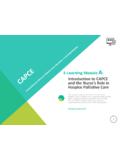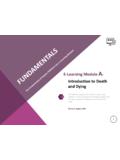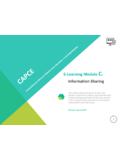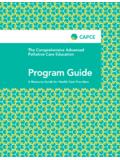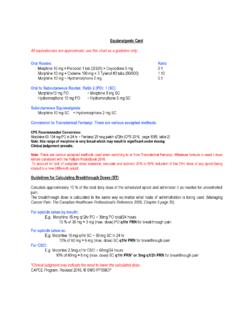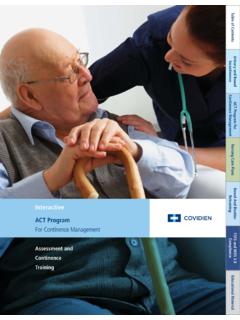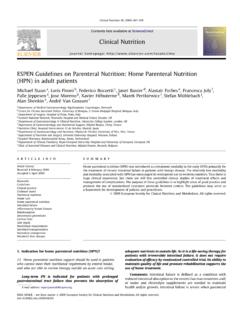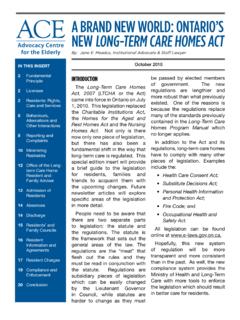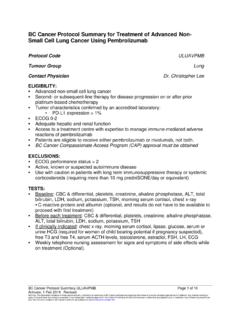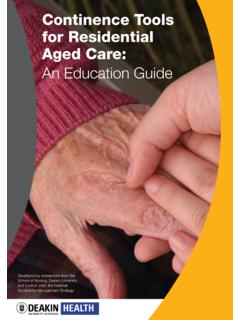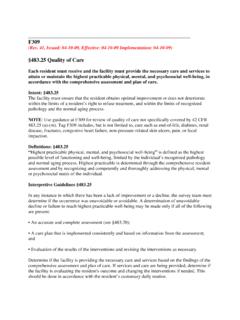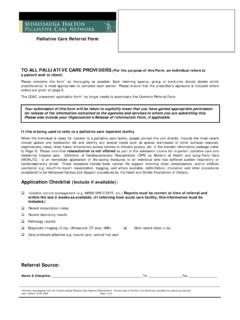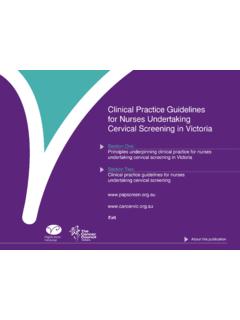Transcription of E-Learning Module Introduction to Hospice Palliative Care
1 1E-Learning Module B: Introduction to Hospice Palliative CareThis Module requires the learner to have read Chapter 2 of the Fundamentals Program Guide and the other required readings associated with the topic. Revised: August 2017 Contents of this E-Learning Module may be reproduced in whole or in part provided the intended use is for non-commercial purposes and full acknowledgement is given to the Southwestern Ontario Hospice Palliative care Education Program and St. Joseph s Health care reference as follows: Southwestern Ontario Hospice Palliative care Education Program. Comprehensive Advanced Palliative care Education E-Learning Modules. London: Southwestern Ontario Hospice Palliative care Education Program, St. Joseph s Health care London; 2013; second edition STARTEDThis E-Learning Module has been designed to consolidate key concepts from the required readings and provide an opportunity to begin applying these concepts through self-directed reflection and scenario-based work, in preparation for the case-based discussions, in-person, with other STARTEDIn this Module you will review the content highlights associated with Chapter would be best if you have read Chapter 2 in advance and have the Program Guide, as well as the Domains of Issues Laminate, with you as you complete this will be prompted to write down your thoughts or ideas during this Module .
2 You can do so in the notes section at the end of Chapter 2 in your Program Guide. These notes are just for you; you are not required to share bringing forward any questions from the E-Learning Modules to your next Peer-to-Peer Exchange or your next Case-Based Learning COVERED Definition of Hospice Palliative care Domains of Issues Foundational Concepts Effective Communication Effective Group Function Ability to Facilitate Change5 DEFINITION OF Hospice Palliative CAREC onsider the following scenarios: A 28-year-old woman has just been diagnosed with MS A 40-year-old woman is debating a double mastectomy after testing has confirmed she has a gene that significantly increases her chance of developing breast cancer. A 65-year-old man is receiving treatment for ALS A 70-year-old man has been told there are no more treatment options for his bowel cancer Which of these people could benefit from Hospice Palliative care ?
3 6 DEFINITION OF Hospice Palliative CAREAll four people could benefit from Hospice Palliative Palliative care : Relieves suffering and improves the quality of living and dying Focuses on the person and family as a unit of care Strives to identify and address needs in all domains Strives to treat all active issues and prevent new issues from occurring Promotes opportunities for meaningful experiences, personal and spiritual growth Should be available from before the diagnosis of the life-limiting illness, or the life-limiting phase of an existing illness, up to and including bereavement support Can be a part of disease modifying therapy or the sole focus of care Can benefit any person and/or family living with or at risk of developing a life-limiting illness7 DEFINITION OF Hospice Palliative CAREIt is important to understand that the approach to care is Palliative .
4 The person is not OF ISSUESLook at your Domains of Issues laminate. Living with a life-limiting illness impacts a person and his or her family in all aspects of their lives. Note that there are multiple issues categorized under 8 headings and that some of these issues may fall under more than one domain. When providing Hospice Palliative care the focus is always on whole person care . Note that the person and family are at the centre of this laminate. This highlights the focus of care by the health care OF ISSUES Consider a person with a life-limiting illness, such as cancer of the bowel. Look at the issues under the physical domain on the Domains of Issues Laminate. In your notes, write down some of the physical issues that this person might be expected to to identify issues in each of the other domains: psychological, social, spiritual, practical, end-of-life care , death management, and loss and CONCEPTSH ospice Palliative care is based on three foundational concepts.
5 These three concepts provide the framework within which you will group ability to facilitate change11 EFFECTIVE COMMUNICATIONE ffective communication among all members of the team is a learned skill and can have a significant impact on the person and family s experience. Through open and truthful dialogue, the person, family and other caregivers can identify and begin to address has a different communication style; however some basic principles and approaches will enhance effective communication not only with the person and family but also amongst the health care COMMUNICATIONThe Program Guide provides a chart that outlines some communication strategies that support effective group function: Common language: Refer to the Glossary Section of the Program Guide. Standard approach to information sharing:Communicate, listen and respond to the reactions that information creates.
6 With the person s permission, share information with the team. Respect the person by informing him or her of the need to share information. Data collection:Use tools such as PPS and ESAS-r, along with appropriate documentation to enhance desired outcomes. Education: Use language appropriate to the person and family s level of understanding. Keep it simple and clear. Provide the information at the pace that is requested. Good listening: The most vital role and the key to building solid COMMUNICATIONA lthough there may be many ways to communicate effectively, the CLASS protocol provides an easy to remember framework that centers on the person s feelings and emotions and readiness to have the conversation. Review the components of the CLASS protocol in Chapter COMMUNICATIONHow we communicate affects the person s illness experience.
7 Consider the following scenario:The person you are caring for says to you the doctor told me to go home and get my house in order . Using the CLASS protocol, write down the steps that you would take to engage this person in a conversation around this statement. Write down two open-ended questions that you might ask the COMMUNICATIONThe CLASS protocol uses a term called empathic response. Empathic responses are genuine responses indicating that you have heard the other person s concerns and understand them on an emotional COMMUNICATIONThe statement That sucks for you that your mom died is a statement I am sorry your mom died is a statement It must be heartbreaking for you to lose your mom; you cared for her so much identifies the emotion a person might be feeling and is an empathic COMMUNICATION As a caregiver, how comfortable are you answering challenging questions?
8 What might get in the way of YOU effectively communicating?18 EFFECTIVE COMMUNICATIONC ommon barriers to effective communication for health care providers include: Fear of producing an emotional reaction in the person Fear of having to say I don t know Lack of knowledge and skills in communicating with the suffering person Concerns about evoking personal emotionsUsing protocols such as CLASS will enhance our ability to learn as we practice and will empower us with the skills to enter into therapeutic GROUP FUNCTIONH ospice Palliative care focuses on Whole Person care to meet the complex needs of the person and family. It requires the involvement of various health care disciplines, with the person and family as core members of the team. The Program Guide describes the stages, feelings, behaviours and tasks of team development.
9 Reflect on a team that you are currently a part of, or were a part of in the past. How did the team work together initially? Over time? How did your experience compare to the information in the Program Guide?20 EFFECTIVE GROUP FUNCTION In your experience working in groups, what important behaviours and/or tasks have helped to build a stronger team? What behaviours and/or tasks made it difficult to build a strong team? Write down your GROUP FUNCTIONThe following have been shown to enable team development: Members making a conscious effort to resolve problems and achieve group harmony More frequent communication Sharing ideas Showing appreciation for individual team members Respect for individual rolesAlternatively, the following can challenge or block team development: Lack of appreciation for individual members Feelings of lack of respect Fear of change22 ABILITY TO FACILITATE CHANGEE veryone on the care team has a role to facilitate a positive change in the illness experience for the person and family.
10 As care providers, increasing our knowledge changes our attitudes and we learn new IT TOGETHERAt the end of this Module you will view a video called The Boulder Analogy. The Boulder Analogy demonstrates the importance of identifying issues, communicating with the team and determining solutions that will positively change the illness experience for the person and may address the issues and be able to facilitate change, however, the person and family are ultimately responsible for choosing how they will live in the particular circumstance. We can only do our part in ensuring that the best care possible is IT TOGETHERC lick this linkto view The Boulder Analogy:Note: If you are not able to link to the Boulder Analogy, copy and paste the following address into your browser s address bar to access the video directly: As you view this 16 minute video, consider the following.
